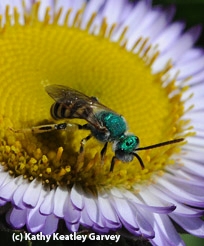
Could it be--a bee?
Yes, that's the metallic green sweat bee, also called an ultra green sweat bee, Agapostemon texanus. This one (below) is a female. Males and females are easily distinguishable. The female is all green, from head to thorax to abdomen, while the male (right) is green on the head and thorax but not on the abdomen.
Native pollinator specialist Robbin Thorp, emeritus professor of entomology at UC Davis, talked about them at the recent UC Davis Pollinator Gardening Workshop, sponsored by the California Center for Urban Horticulture.
The Agapostemon are members of the Halictinae family. They are "often called sweat bees because in hot weather they are attracted to human perspiration, which they lap up, probably for the salt it contains," according to the book, Bees of the World, by Christopher O'Toole and Christopher Raw.
Some of the family's many genera, including Agapostemon, are restricted to the New World. Halictus and Lasioglossum "are common to the Old and New Worlds," the authors write.
Coreopsis, also called tickseed or coreopsis, is a genus of flowering plants in the family Asteraceae.
We spotted the female metallic green sweat bee at the Loch Lomond Marina, San Rafael. We captured the image of the male several years ago on a seaside daisy at the Mostly Natives Nursery, Tomales.
Green sweat bees will be among the bees featured in the book, "California Bees and Blooms: A Guide for Gardeners and Naturalists," to be published in the fall of 2014 by Heyday Press. It's the work of Gordon Frankie of UC Berkeley; Robbin Thorp of UC Davis; photographer Rollin Coville of the Bay Area; and Barbara Ertter of UC Berkeley. It will contain nearly 30 of the most common bee genera in California.
Frankie, Thorp, Coville and Ertter (and others) also published "Native Bees Are a Rich Natural Resource in Urban California Gardens" in California Agriculture.
Attached Images:

